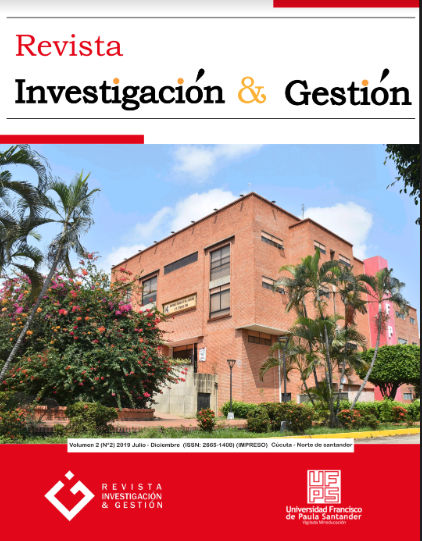Designs and strategies for the formalization of employment in the city in the city of Cúcuta
Diseños y estrategias para la formalizacion del empleo en la ciudad en la ciudad de Cúcuta
Main Article Content
This present work contains the analysis of the organizational climate of the strategies for the formality of employment in the city of Cucuta, North of Santander, this precedes the emphasis on the problem that afflicts and considers properly an objective level in the radical search to lower the high index of informality in this city, in terms of labor competencies, the effects generated by the alternative vision of didactic bases in the direction of greater participation that are taught to contribute to the recovery of public spaces are socialized and additionally allow adverse policies to be established for good results. in favor of the recovery of a legal, formal job. The commercial structure within the regional economic context forms small enterprises of more sustainable entrepreneurship in the face of the state of labor informality, considered in the city of Cucuta formal work consisting of small companies that have the largest. It contains the concepts on the state of labor informality of international, national and local order. Informal companies present relevant conclusions on the organizational level characteristics to improve with considerable strategies as a primary point to the search for opportunities for this population that emerges proportionate and positive results.
The topic was born with the investigation of different informal work modalities practiced in the city, the environmental conditions and that this work modality is becoming a custom, through indirect analyzes, to determine the demographic information and know the working conditions of the population and having an attitude towards informality, surveys were applied to informal workers.
Downloads
Article Details
Cepal. (2018). Perspectivas económicas de América latina. Repensando las instituciones, Éditions OCDE, París. Obtenido de https://repositorio.cepal.org/bitstream/handle/11362/43513/1/LEO2018_es.pdf
DANE. (2009). Metodología Informalidad gran encuesta integrada de hogares-GEIH. Obtenido de https://www.dane.gov.co/files/investigaciones/boletines/ech/ech_informalidad/metodologia_informalidad.pdf
Geih, (2018). Mercado laboral (Empleo y desempleo) Históricos. Obtenido de https://www.dane.gov.co/index.php/estadisticas-por-tema/mercado-laboral/empleo-y-desempleo/geih-historicos
Gómez-Naranja, L.G. (2007). la informalidad em la economía, algo incuestionable. Semestre Económico, 10 (19), 47-67. Obtenido de http://www.scielo.org.co/pdf/seec/v10n19/v10n19a4.pdf
Martínez, D., & Infante, R. (2019). La informalidad en la visión OIT: evolución y perspectivas para América Latina Obtenido de: https://www.ilo.org/santiago/publicaciones/reflexiones-trabajo/WCMS_729999/lang--es/index.htm
Muñoz-Caicedo, A. & Chois-Lenis, P. M. (2014). Riesgos laborales en trabajadores del sector informal del Cauca, Colombia. Revista de la Facultad de Medicina. 62 (3), 390-399 Obtenido de http://www.scielo.org.co/scielo.php?pid=S0120-00112014000300007&scri DOI: https://doi.org/10.15446/revfacmed.v62n3.38682
pt=sci_abstract&tlng=es
Naranjo Pereira, M. L. (2007). Autoestima: un factor relevante en la vida de la persona y tema esencial del proceso educativo. Revista Actualidades Investigativas en Educación 7 (3). https://revistas.ucr.ac.cr/index.php/aie/article/view/9296 DOI: https://doi.org/10.15517/aie.v7i3.9296
Ordoñez, A. & Ochoa-Valencia, D., (2004). Informalidad en Colombia, causas, efectos y características de la economía del rebusque. Estudios Gerenciales, 20 (90) Obtenido de http://www.scielo.org.co/scielo.php?script=sci_arttext&pid=S0123-59232004000100005
Ramírez-Zambrano, J. R.., Zambrano-Miranda, M.J., Mogrovejo, J.M & Carreño-Montaño, J.L (2016). Informalidad laboral en los departamentos Norte de Santander, Nariño, La Guajira y Cesar Apuntes del CENES, 35 (62), 125-145 Obtenido de http://www.scielo.org.co/pdf/cenes/v35n62/v35n62a05.pdf DOI: https://doi.org/10.19053/22565779.5232
Rebossio, A. (2014). ¿Cuáles son los países con más y menos empleo informal? Blog planeta futuro. Obtenido de https://blogs.elpais.com/eco-americano/2014/10/cu%C3%A1les-sonlos-pa%C3%ADses-con-m%C3%A1s-y-menos-empleo-informal.html DOI: https://doi.org/10.18356/05665cd0-es
Restrepo-Jiménez, D.M (2011). La informalidad laboral de América Latina: ¿Explicación estructuralista o institucionalista? Universidad del Valle. Obtenido de https://revistas.unal.edu.co/index.php/ceconomia/article/view/37973/40282
Rodríguez-Cabrera, Y. (2015). El comercio informal, una afrenta a los poderes establecidos. Irg. Obtenido de http://www2.institut-gouvernance.org/es/experienca/fiche-experienca-10.html
Roldán, P. N. (2019). Capital. Economipedia. Obtenido de https://economipedia.com/definiciones/capital.html
Saldarriaga-Diaz, J. M., Betancur-Ramírez, G.B. & Vélez-Zapata, C. (2014). Estrategias de Mercadeo. Semestre Económico, 19 (39), 155-172 Obtenido de http://www.scielo.org.co/pdf/seec/v19n39/v19n39a08.pdf
Villán-Bustamante, D., (2019). Tasa de informalidad en Cúcuta se mantuvo en el mismo nivel.La opinión. Obtenido de https://www.laopinion.com.co/economia/tasa-de-informalidad-en-cucuta-se-mantuvo-en-el-mismo-nivel#:~:text=C%C3%BAcuta%20y%20su%20%C3%A1rea%20metropolitana,m%C3%B3vil%20septiembre%2Dnoviembre%20
de%202018.







